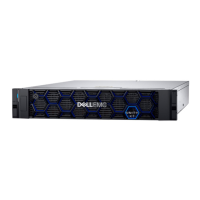The SP Ethernet service port interface provides the same functions and features as
the service SSH interface and is also subject to the same restrictions. The difference
is that users access the interface through an Ethernet port connection rather than an
SSH client.
For a list of service commands refer to the
Service Commands Technical Notes
.
SMI-S provider
The SMI-S provider does not introduce any change with regards to security. An SMI-S
client connects to the storage system through HTTPS port 5989. The login
credentials are the same as those of Unisphere UI or CLI users. All security rules that
apply to UI and CLI users also apply to SMI-S connections. Unisphere UI and CLI users
can authenticate using the SMI-S interface. No separate users are defined for the
SMI-S interface. Once authenticated, the SMI-S client has the same privilege as
defined for those Unisphere UI and CLI users. The
SMI-S Provider Programmer's Guide
for your storage system product provides information about configuring this service.
vSphere Storage API for Storage Awareness support
vSphere Storage API for Storage Awareness (VASA) is a VMware-defined, vendor-
neutral API for storage awareness. A VASA Provider (VP) is a storage‐side software
component that acts as a storage awareness service for vSphere. ESXi hosts and
vCenter Server connect to the VP and obtain information about available storage
topology, capabilities, and status. Subsequently, vCenter Server provides this
information to vSphere clients. VASA is used by VMware clients rather than Unisphere
clients.
The VP runs on the active Storage Processor (SP) of the storage system. The
vSphere user must configure this VP instance as the provider of VASA information for
each storage system. In the event that an SP goes down, the related process will
restart on the peer SP, along with the VASA VP. The IP address fails over
automatically. Internally, the protocol will see a fault when obtaining configuration
change events from the newly active VP, but this will cause an automatic
resynchronization of the VASA objects without user intervention.
The storage system provides VASA 3.0 and VASA 2.0 interfaces for vSphere 6, and
VASA 1.0 interfaces for vSphere 5.x.
VASA 1.0 is used for monitoring only and is used by VMware clients rather than
Unisphere clients. VASA 1.0 is a reporting interface only and is used to request basic
information about the storage system and the storage devices it exposes to the virtual
environment in order to facilitate day-to-day provisioning, monitoring, and
troubleshooting through vSphere:
l
Storage visibilty: internally detects property changes, sending the updated
information to vCenter
l
Health and Capacity alarms: internally monitors for health status changes and for
capacity related thresholds being crossed, raising the appropriate alarms to
vCenter:
n
health status for the array, SPs, I/O ports, LUNs, and File Systems
n
class-level change indications for a change in health status for any of these
objects
n
space capacity alarms for LUNs and File Systems
l
VASA storage capabilities: internally monitor for storage capability changes,
reporting updated capabilities to vCenter
Access Control
SMI-S provider 17

